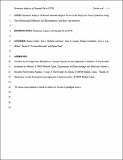Por favor, use este identificador para citar o enlazar a este item:
http://hdl.handle.net/10261/30670COMPARTIR / EXPORTAR:
 SHARE
BASE SHARE
BASE
|
|
| Visualizar otros formatos: MARC | Dublin Core | RDF | ORE | MODS | METS | DIDL | DATACITE | |

| Campo DC | Valor | Lengua/Idioma |
|---|---|---|
| dc.contributor.author | Cortón, Marta | - |
| dc.contributor.author | Botella-Carretero, José I. | - |
| dc.contributor.author | López, Juan A. | - |
| dc.contributor.author | Camafeita, Emilio | - |
| dc.contributor.author | San Millán, José L. | - |
| dc.contributor.author | Escobar-Morreale, Héctor F. | - |
| dc.contributor.author | Peral, Belén | - |
| dc.date.accessioned | 2010-12-22T10:32:41Z | - |
| dc.date.available | 2010-12-22T10:32:41Z | - |
| dc.date.issued | 2007-03 | - |
| dc.identifier.citation | Human Reproduction | es_ES |
| dc.identifier.issn | 0268-1161 | - |
| dc.identifier.uri | http://hdl.handle.net/10261/30670 | - |
| dc.description.abstract | BACKGROUND: Our aim was to study the protein expression profiles of omental adipose tissue biopsies obtained from morbidly obese women with or without polycystic ovary syndrome (PCOS) at the time of bariatric surgery to evaluate the possible involvement of visceral adiposity in the development of PCOS. METHODS: Ten PCOS patients and nine control samples were included. We used two-dimensional difference gel electrophoresis (2D-DIGE) followed by in-gel digestion, and mass spectrometry (MS) of selected protein spots. RESULTS: The 2D-DIGE technology allowed the analysis of similar to 1840 protein spots in the comparative study of control and patient proteomes, revealing 15 statistically significant spot changes (> 2-fold, P < 0.05). Unambiguous protein identification was achieved for 9 of these 15 spots by MS. This preliminary study revealed differences in expression of proteins that may be involved in lipid and glucose metabolism, oxidative stress processes and adipocyte differentiation; they include proapolipoprotein Apo-A1, annexin V, glutathione S-transferase M3 (GSTM3), triosephosphate isomerase, peroxiredoxin 2 isoform a, actin and adipocyte plasma membrane-associated protein. The most relevant finding was an increase of GSTM3 in the omental fat of PCOS patients confirming previous studies conducted by our group. CONCLUSIONS: Proteomic analysis of omental fat reveals differential expression of several proteins in PCOS patients and non-hyperandrogenic women presenting with morbid obesity. The application of this novel methodology adds further evidence to support the role of visceral adiposity in the pathogenesis of PCOS. | es_ES |
| dc.language.iso | eng | es_ES |
| dc.publisher | Oxford University Press | es_ES |
| dc.relation.isversionof | Preprint | - |
| dc.rights | openAccess | es_ES |
| dc.subject | Oxidative stress | es_ES |
| dc.subject | Insulin-resistance | es_ES |
| dc.subject | Glut4 translocation | es_ES |
| dc.subject | Phosphatidylinositol 3-kinase | es_ES |
| dc.subject | Cardiovascular diseases | es_ES |
| dc.subject | 3T3-L1 adipocytes | es_ES |
| dc.subject | Androgen excess | es_ES |
| dc.subject | Risk-factors | es_ES |
| dc.subject | Women | es_ES |
| dc.subject | Gene | es_ES |
| dc.title | Proteomic analysis of human omental adipose tissue in the polycystic ovary syndrome using two-dimensional difference gel electrophoresis and mass spectrometry | es_ES |
| dc.type | preprint | es_ES |
| dc.identifier.doi | 10.1093/humrep/dem380 | - |
| dc.relation.publisherversion | http://dx.doi.org/10.1093/humrep/dem380 | es_ES |
| dc.type.coar | http://purl.org/coar/resource_type/c_816b | es_ES |
| item.grantfulltext | open | - |
| item.openairetype | preprint | - |
| item.cerifentitytype | Publications | - |
| item.languageiso639-1 | en | - |
| item.fulltext | With Fulltext | - |
| item.openairecristype | http://purl.org/coar/resource_type/c_816b | - |
| Aparece en las colecciones: | (IIBM) Artículos | |
Ficheros en este ítem:
| Fichero | Descripción | Tamaño | Formato | |
|---|---|---|---|---|
| Human Reproduction 2008 vol23 n3 pp651.pdf | 3,82 MB | Adobe PDF |  Visualizar/Abrir |
CORE Recommender
Page view(s)
378
checked on 15-may-2024
Download(s)
384
checked on 15-may-2024
Google ScholarTM
Check
Altmetric
Altmetric
NOTA: Los ítems de Digital.CSIC están protegidos por copyright, con todos los derechos reservados, a menos que se indique lo contrario.
